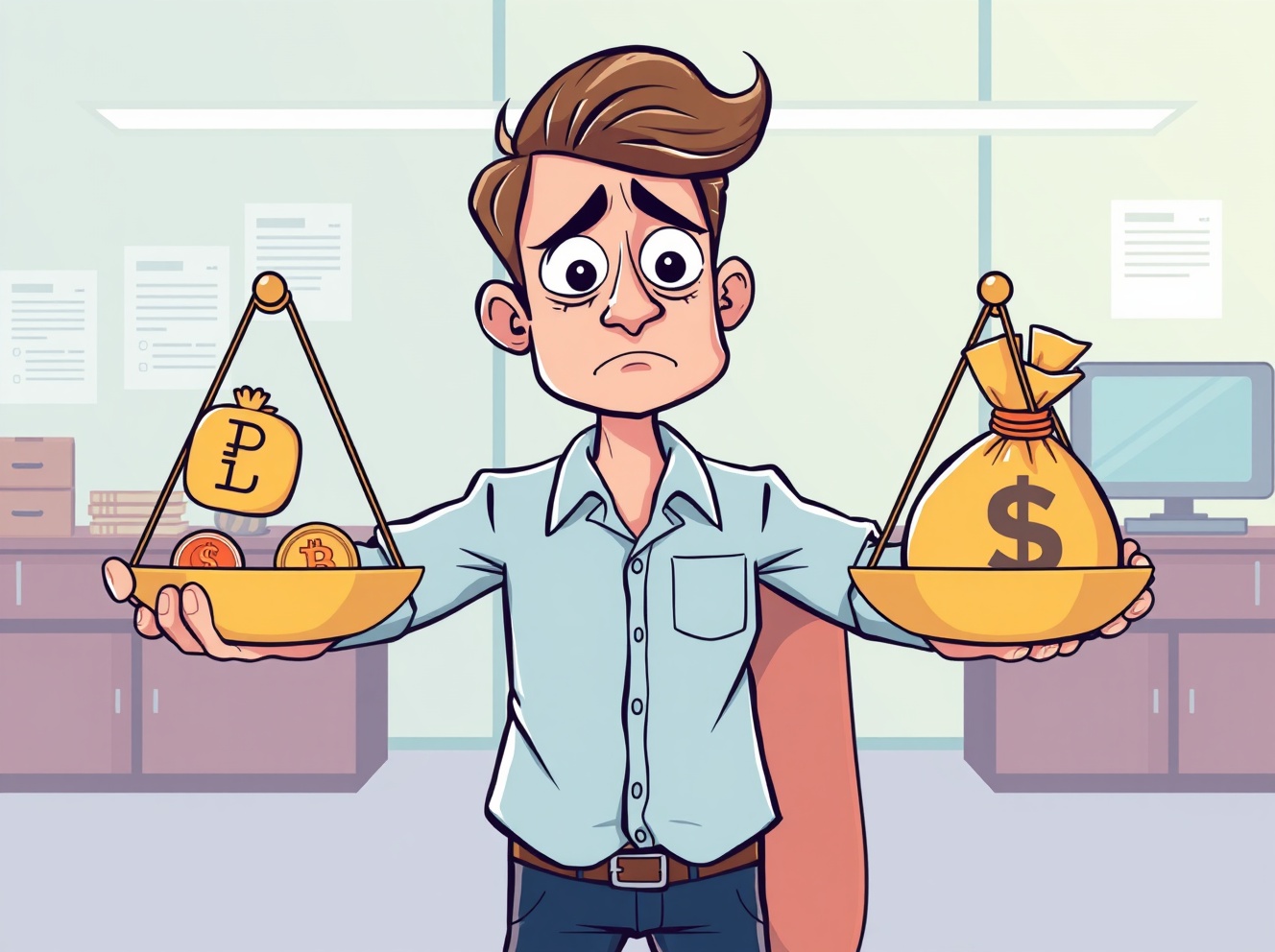
Bitcoin price is struggling below $105,000. BTC could continue to move down if it stays below the $104,200 resistance. Bitcoin started a fresh decline below the $104,000 support. The price is trading below $104,000 and the 100 hourly Simple moving average. There was a break above a bearish trend line with resistance at $103,000 on the hourly chart of the BTC/USD pair (data feed from Kraken). The pair might continue to move down if it fails to surpass the $105,000 zone. Bitcoin Price Faces Resistance Bitcoin price failed to stay above the $105,000 support level and started a fresh decline . BTC dipped below $103,500 and $102,000 to enter a bearish zone. The decline was such that the price even spiked below the $100,000 support. A low was formed at $98,900 and the price recently started a recovery wave. There was a move above the 23.6% Fib retracement level of the downward move from the $111,000 swing high to the $98,900 low. Besides, there was a break above a bearish trend line with resistance at $103,000 on the hourly chart of the BTC/USD pair. However, the bears remained active near $104,000. Bitcoin is now trading below $104,000 and the 100 hourly Simple moving average . If the bulls attempt another recovery wave, the price could face resistance near the $103,500 level. The first key resistance is near the $104,000 level. The next resistance could be $105,000 and the 50% Fib retracement level of the downward move from the $111,000 swing high to the $98,900 low. A close above the $105,000 resistance might send the price further higher. In the stated case, the price could rise and test the $106,500 resistance. Any more gains might send the price toward the $107,500 level. The next barrier for the bulls could be $108,500 and $108,800. Another Decline In BTC? If Bitcoin fails to rise above the $104,000 resistance zone, it could continue to move down. Immediate support is near the $102,150 level. The first major support is near the $100,500 level. The next support is now near the $100,000 zone. Any more losses might send the price toward the $98,800 support in the near term. The main support sits at $97,500, below which BTC might struggle to recover in the near term. Technical indicators: Hourly MACD – The MACD is now gaining pace in the bearish zone. Hourly RSI (Relative Strength Index) – The RSI for BTC/USD is now below the 50 level. Major Support Levels – $102,150, followed by $100,500. Major Resistance Levels – $103,500 and $104,000.
NewsBTC
You can visit the page to read the article.
Source: NewsBTC
Disclaimer: The opinion expressed here is not investment advice – it is provided for informational purposes only. It does not necessarily reflect the opinion of BitMaden. Every investment and all trading involves risk, so you should always perform your own research prior to making decisions. We do not recommend investing money you cannot afford to lose.
Market Strategist Says Ripple Does Not Control XRP. Here’s why

Financial expert Levi Rietveld recently addressed a long-standing misconception surrounding Ripple and XRP , offering a clear explanation of their relationship and how the XRP ecosystem functions. In his remarks, he emphasized that XRP is not owned or controlled by Ripple. Instead, he described it as an open-source technology that operates independently, supported by a network of developers and organizations contributing to its evolution. Rietveld highlighted that XRP is integrated into Ripple’s product stack as part of its broader technological solutions, but its scope extends far beyond Ripple’s operations. According to him, there are numerous other companies building within the XRP ecosystem , each led by independent teams and executives. His statements aimed to correct a recurring misunderstanding in public discourse that conflates Ripple’s corporate structure with the decentralized technology that underpins XRP. Ripple Doesn’t Control #XRP pic.twitter.com/BR73pZKKlG — Levi | Crypto Crusaders (@LeviRietveld) November 2, 2025 The Open-Source Nature of XRP Ledger Rietveld went on to detail how the governance of the XRP Ledger (XRPL) operates under an open-source framework. He explained that changes or amendments to the ledger require community consensus, specifically an 80% approval threshold, ensuring that no single entity—including Ripple—can unilaterally dictate network decisions. This governance model underscores XRP’s decentralization, as it allows the community to shape the protocol based on collective agreement rather than centralized control. To further illustrate this point, Rietveld mentioned instances where Ripple opposed certain amendments that were ultimately approved by the wider community. Conversely, some proposals championed by Ripple have also gained support and passed through the established consensus process. This balance of power reflects the XRPL’s autonomy and reinforces the argument that Ripple functions as one participant among many within a broader ecosystem. We are on X, follow us to connect with us :- @TimesTabloid1 — TimesTabloid (@TimesTabloid1) June 15, 2025 Educating the Market on Decentralization Rietveld stressed the importance of education in dispelling false narratives about XRP’s governance. He noted that many misconceptions stem from a lack of understanding about how open-source technologies work. By clarifying that Ripple has a CEO , while XRP itself does not, Rietveld sought to make a clear distinction between the company and the decentralized technology it utilizes. His explanation provides valuable context to ongoing discussions about decentralization and corporate involvement in blockchain networks. It reinforces the idea that XRP’s development and governance are not confined to any single organization, but rather shaped by a distributed community of contributors. Rietveld’s remarks serve as a reminder of the foundational principles behind the XRP Ledger—community-driven innovation, transparency, and decentralized governance. His clarification helps ensure that market participants, developers, and observers understand the true nature of XRP’s ecosystem, separate from Ripple’s corporate identity. Disclaimer : This content is meant to inform and should not be considered financial advice. The views expressed in this article may include the author’s personal opinions and do not represent Times Tabloid’s opinion. Readers are advised to conduct thorough research before making any investment decisions. Any action taken by the reader is strictly at their own risk. Times Tabloid is not responsible for any financial losses. Follow us on X , Facebook , Telegram , and Google News The post Market Strategist Says Ripple Does Not Control XRP. Here’s why appeared first on Times Tabloid . NewsBTC

Everyone’s Giving Up On Bitcoin? Crypto Exec Says That’s Exactly Why It Will Rise
The crypto market looks beaten down again, but one veteran investor says that may be the exact signal to stay calm. Related Reading: Bitcoin’s Grip Holds — But Signs Of Weakness Are Piling Up: Analyst Bitwise Chief Investment Officer Matt Hougan believes Bitcoin’s deep sell-off — now dragging prices below $102,000 for the first time since the last five months — is more about panic than fundamentals. Retail Sentiment At ‘Max Desperation’ Hougan told CNBC this week that small traders are hitting a breaking point. “It’s almost a tale of two markets,” he said, describing what he sees as “max desperation” among retail investors after months of heavy losses and leverage blowouts. He called the mood the most depressed he’s ever witnessed in crypto. For him, that level of hopelessness might be the final stage before the market finds its footing again. Institutional Flows Continue To Matter While smaller traders are backing off, larger investors appear to be sticking around. According to reports, financial advisors and institutional funds are still adding to positions through Bitcoin ETFs such as iShares Bitcoin Trust (IBIT), Fidelity Wise Origin Bitcoin Fund (FBTC), and Grayscale Bitcoin Trust (GBTC). The weekly inflows have slowed since the middle of the year, but they remain positive — a sign, Hougan says, that big money hasn’t lost faith. Hougan argues that this split between retail panic and institutional confidence could shape how the market recovers. “When I talk to advisors and institutions,” he said, “they’re still excited to allocate to an asset class that, if you zoom out, is delivering strong returns over the past year.” Solana Staking Interest And ETF Activity The growing influence of crypto funds goes beyond Bitcoin. Hougan said Bitwise’s new Solana Staking ETF (BSOL) pulled in more than $400 million in its first week before dropping nearly 20% since launching on Oct. 28. Even so, he sees strong appetite for professionally managed crypto exposure among investors who prefer structured products over direct trading. Related Reading: ‘Good News’ Finally Arrives For SHIB Army As Team Unveils New Update Not everyone agrees on how fast a rebound might come. Strategy CEO Michael Saylor recently predicted Bitcoin could hit $150,000 by year end — a call Hougan considers bold but not impossible. He said a move toward $125,000 or even $130,000 is achievable if selling pressure keeps fading and demand from institutions grows. For now, the market still feels fragile. Hougan admits there could be more downside before prices turn around, but he thinks the end of the sell-off is close. Retail sentiment may be collapsing, yet institutional optimism is holding firm — and that, he says, could be the fuel for Bitcoin’s next rally. Featured image from Unsplash, chart from TradingView NewsBTC











